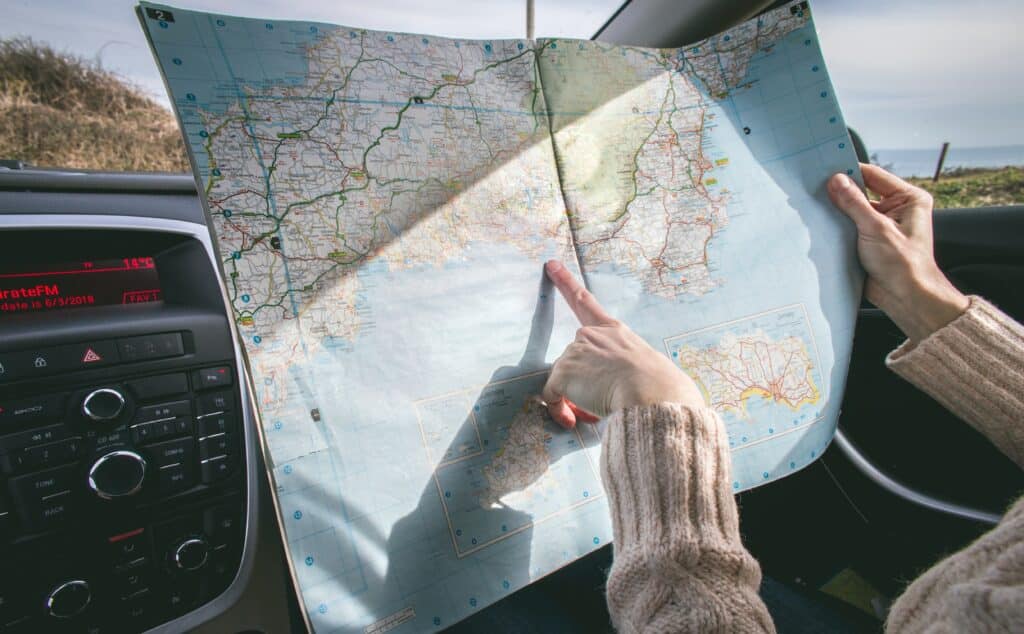There are no better ways to relax and have fun than to plan a trip! Enjoying exotic beaches, tempting food, gorgeous weather, and luxurious accommodations alone sends chills. But all those dreamy thoughts come to nothing if you don’t know how to plan a trip because things start to look less exciting.
Taking a trip is one of the best ways to unwind, not to mention traveling can also be educational. Before dashing out to the airport, you’ve got to sit for a moment to plan your vacation down to the tiniest details properly. Otherwise, poor planning will ultimately be a killjoy and prevent you from having the time of your life.
Let’s find out how to plan a trip and ensure you have as much fun as possible. In this post, we’ve made things simple for you in this article, so keep reading to find out everything you know about how to plan a trip.

How to Plan A Trip
After deciding on a trip, your itinerary is ready, and your piggy bank is about half-full. What’s your next move? Easy – the planning, right? In this section, you’ll find out how to go about your trip’s details, from booking flights and accommodation to insurance, so read on!
1. Research
Suppose you’ve picked out your destination and made all the plans for your trip. But there may be stellar last-minute online deals for you. So, the best thing to do is to find out about the activities you have in mind and look for their price slashes, especially if it’s around the holidays.
Also, trendy destinations always have hashtags, so you could look them up on social media or search for location geotags. Most importantly, check out travel blogs to get more personal advice from a fellow tourist’s experience.
One of the things to research for the price changes, remember you’ve been saving for a few months, so there must have been some price movements. So, you must surf online and make the necessary adjustments to your budget estimate.
Lastly, while doing your research, it’s essential to understand the culture of your chosen destination. Thus, an excellent way to do this is to learn their conversational language and research the popular food and snacks you might love.
2. Get Your Travel Documents and Identification Ready
Is your passport up-to-date? Do you have your documents at hand? If you’re traveling abroad, does your destination country insist you get a visa?
Ignoring these documents will likely jeopardize you and spoil your trip plan. Countries requiring visas will send you home; don’t try to travel without one.
Finally, always have multiple photocopies of your documents and store the originals somewhere safe. No need to cry because your paper is missing or stained; you’re better off avoiding that situation altogether.
3. Book your Flight and Reserve Accommodations
After researching and finalizing your plans:
- Book your flight and reserve accommodations.
- Run away from that last-minute rush, whether it’s with your flight, lodgings, or even entertainment.
- Whenever you can pay online to avoid the long lines at ticket stands, don’t hesitate.
When is the best time to make reservations? Pay early enough; you want to be privy to deals and price cuts. Any expert would tell you to be somewhere in the middle.
Yet, waiting too long will make you one of the last-minute guys who pay more due to price hikes. Travel guides usually recommend making reservations about two to three months prior, not early, but not late.
There are many search engines for booking flights. Popular ones include Google Flights and Skyscanner. Alternatively, you can book directly with the airline if you’re used to their services and methods.
4. Redeem Travel Insurance
Cue another eye-roll because insurance is one of the dreariest topics to discuss. You do not wish for bad luck, so why spend your money preventing it? Not to mention, it doesn’t sound very optimistic sometimes.
If only life worked that way! Though nobody asks for accidents, they still happen, and the best thing you can do is protect yourself where possible. You could get sick, robbed, or jumped, and that’s where your insurance will save the day.
You don’t have to cough out a fortune for premium prices. Here’s an affordable travel insurance company for you: safetywing.com

The Don’ts of Planning a Trip
We’ve talked extensively about how to plan a trip, but what about common mistakes? When planning, you should avoid a few things to get the most out of your journey.
1. Creating an Overfull Itinerary
Nobody likes a boring vacation; a well-planned trip should include many fun activities. However, packing too much into your itinerary won’t necessarily translate to more fun.
Instead, you’ll find yourself always hurrying off to a new location. Give yourself breathing space, and make your plans as flexible as possible.
2. Not Checking Your Flight’s Layover
Air travel usually includes connecting flights; the last thing you need is a short time between those flights.
Always ensure the flight you choose gives you a time allowance for possible delays before your next flight begins. Missing your connecting flight is a terrible way to start that long-awaited trip.
3. Not Double-checking
Still, you won’t believe how many people forget to pack important documents or make reservations. Who wouldn’t think to double-check, right? Shouldn’t it be the first thing on your list of last-minute precautions?
Double and even triple-checking don’t make you a panicky granny; instead, it makes you responsible. Check that everything is in place, from your papers to the names on your reservations, and confirm your flight times.
4. Not Giving a Vacation Notice
We can only talk about how to plan a trip by mentioning notifications. Traveling without notifying the appropriate people doesn’t make you professional or mature.
Whether it’s a close friend, family, or your boss at the office, inform someone of your absence, especially if you’re traveling alone.
5. Packing Too Many Valuables
Naturally, you want to travel with that stunning Chanel bag or show off your new designer sunglasses at the beach. But remember, too much bling puts you at risk, particularly in big cities.
Unless you can easily afford a replacement, travel with less conspicuous items. Furthermore, withdraw as little cash as possible; only take what you’ll need on the journey. You can always visit the ATM at your destination.
6. Overplanning
Confusing? After all, we did say you should plan, so is there a negative side to planning?
Yes. The internet is chock-full of information; the truth is, too much information can be detrimental. There’ll always be something to change, a better offer or a more admirable destination.
So, don’t get sucked into this rabbit hole; you’ll never get around to your trip. Carefully plan your journey, but remember that no plan can ever be perfect. Stick to what makes you and your travel buddies happy, and embrace any bumps along the way.

5 Things to Consider Before Planning a Trip
Planning a trip isn’t a day’s job; you’ve got to consider many things and factors if you want to enjoy a lovely vacation. So, here are some vital things to consider before you take that next flight or train!
1. Solo or Group trip?
From the title, you’ve probably already guessed your first move. It would be best to decide whether you’re traveling in a group, as a pair, or as a lone ranger.
Although it may sound insignificant, the number of people in your travel party can make or break your plans if you’re traveling alone (or maybe with that special someone), then lucky you! You get to do whatever you see fit.
On the other hand, traveling in a group can cause some complications if extra care isn’t taken. While figuring out how to plan a trip, ensure you factor in activities others will love.
2. Destination
Visiting historic cities is fun, but you must keep a few things in mind. An unarguably best part of planning is picking a suitable destination to admire stunning images of beautiful beaches and bustling.
Here are some tips you should follow while looking for a suitable destination for your vacation:
- First, narrow your location down as much as possible. Planning a trip to Venice is more straightforward than planning a trip to Italy or Europe.
- Try to recall that stunning town you’ve always wanted to visit and make it your destination. Better still, hop on to Pinterest or a renowned travel site for more specific suggestions.
- Consider your personality, likes, and dislikes while picking the location. An introvert is likelier to enjoy quiet, beautiful towns with serene beaches over a major city. On the contrary, look for sprawling cities with nightlife if you’re more extroverted.
- Remember to include weather, cuisine, security, and accommodation details when picking your destination. That’ll help you make little decisions like what clothes to pack and when it’s safest to move around.
You can also check out tourist reviews and ratings; learning from other people’s experiences makes you a savvy traveler. With these little tips, you’ll know what to expect when you eventually take your trip.
Ultimately, wherever you choose has to work for every member of your traveling party unless you’re riding solo. Some tour websites you can explore are GetYourGuide and Musement.
3. Timing
Intentionality is everything, which still applies when you’re learning to plan a trip. It’s not enough to say you’re traveling; your entire plan hangs in the balance until you decide when exactly you’re jetting off.
Now, sit back and ask yourself, when is it most convenient for you to travel? There’s no sense in shelling out your hard-earned money for a trip and not soaking in every moment because you’re pressed for time. So, depending on your schedule, take out enough vacation time, mark specific dates, and you’re ready to roll!
Remember, the more specific your timeline, the better. For example, don’t just say, ‘I’ll travel next month.’ Instead, say, ‘I’ll travel on the 13th and spend two weeks at my destination.’ Of course, you can change this date if the need arises, but being specific from the start will help you plan more decisively. This way, you’ll also know the exact amount you need for your trip.
4. Budget
We’re done with the who, when, and where. Now, let’s get down to serious business – the money. This part isn’t as fun as the first three; it can be pretty thorough but should not be overlooked.
On reading the word ‘budget,’ you probably thought, ‘Oh please, spare me the boring talk.’ After all, it’s a vacation! Plus, you’ve saved and toiled all year, so why not loosen up?
Well, sorry to burst your bubble, but imagine taking that fancy trip and running out of money in the middle of your journey. That means you won’t be able to afford transportation or buy pretty souvenirs! Deciding your destination and planning without sufficient funding or budgeting will cut your fun short, especially if there is reckless spending.
So, let’s look at all aspects of budgeting and show you incredible ways to save up when planning.
I. Determine the Cost of Your Trip
The thing about traveling is you can decide how much you spend. You can rough it up with your squad in mid-range accommodations or splash your cash in a luxury hotel. Make sure your bank account can handle whatever option you choose.
Additionally, while adding up costs, account for logistics like flights or petrol prices (for road trips), feeding, entertainment, and sightseeing. You’ll often hear that it’s wise to overestimate, and that’s true because your total cost should have allowances for little price jumps here and there.
Many sites help you put this itinerary and the associated costs together. A good example is www.tripadvisor.com.
II. Save
Saving is the hardest part of planning a trip. Most people panic at saving, but it’s way easier than you’d think. Your estimate is staring at you, so it’s time to cough out the money. For instance, you have six months to your proposed date, and your trip will cost $1000. That means you need to save about $6 daily.
Where to carve out $6? As we’ve previously established, it’s not a difficult task. Go over your daily habits, and you’ll discover that you have a lot of costly and unnecessary expenses.
Those frequent visits to your nail tech can wait. You don’t have to eat out or order food; homecooked meals will save you some money. That coffee and bagel you grab on your way to work every morning aren’t so important. Instead, try making a mug at home for yourself. It isn’t a lesson in money management, but pick up a few good financial habits if you want to have a blast on your trip.
III. Apply for a Travel Credit Card
A travel credit card is a credit card that rewards you in points or miles when you make purchases during your trips or everyday life. Travel credit cards can be your best friend if you know how to use them. Never heard of one? Don’t worry; we’ll tell you what they are and how they work.
So, when you buy that pretty notebook that says ‘I love Paris’ with your travel credit card, you get rewarded. The good thing about reward points is that you can redeem them to get hotel stays, flights, and much more. You won’t be charged for making a foreign transaction with these cards.
You probably have that friend that always seems to be hopping around the world, and you keep wondering, ‘how does this person do it?’ Well, it may be your friend’s secret, and the process is called travel hacking. You, too, can collect points for doing your favorite things, especially if you enjoy taking trips frequently.
There’s a world of information about travel credit cards out there; here’s an article to help you out. Note that travel credit cards are still credit cards, so don’t spend what you can’t pay off.
Add the Final Touches
At this stage, you’re almost set. All you need are a few final touches, and voila! Travel time.
1. Shop
Always shop for your necessities, those essentials you know you’ll need. Be it a language book, maps, camera equipment, binoculars, or any other gear, ensure you have it on hand.
You also need the right clothes, especially if you are going somewhere cold; you need to get lots of wool and comfy cashmere. You’ll need your swimwear, coverups, shorts, hats, and sunscreen for the beach.
Don’t think taking a road trip spares you; you have many more things to consider. Think car spare parts, safety equipment, road snacks, and water. Some car games would also be excellent, as things can get lengthy.
2. Get packing
Finally! At this point, you’ll be excited, but read these tips before you start rushing around your home.
Pack light; while it may appear tempting, especially if you love your fashion, It must be emphasized; everyone detests lugging around too many bags at the airport. A few pairs of shoes and a comfy bag are enough; there’s no need to put on a runway show. Build a capsule, staple your wardrobe with neutrals and separates, and take it with you.
Doing this will leave space in your bag for souvenirs and any extras you’re getting on your way home. Remember that you pay for excess luggage unless you have the cash to spare; minimalism is best!
Ready to Plan Your Next Trip?
Whew! It’s a lot, and you’re probably wondering, ‘Can I pull this off?’ Yes, you can and should take this bold step. Learning to plan a trip is a commitment and takes a boatload of discipline, hard work, and attention to detail.
Regardless, you won’t regret the months you spent going over things. Follow these steps to a fault and begin planning that trip today. You’ll return from your vacation feeling refreshed, energized, and ready to tackle life.
Once you have successfully planned your trip, the next step is to Pack a Suitcase. Remember to comment on your thoughts about the article and let us know what we can do better.


